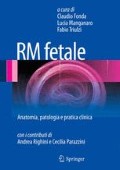Riassunto
Lo studio del distretto cardiovascolare e delle patologie cardiache congenite in utero con Risonanza Magnetica (RM), stando anche a recenti studi pubblicati in letteratura, è ancora pioneristico anche se possibile, in relazione alle numerose limitazioni di ordine tecnico solo parzialmente superabili [1, 2]. Tuttavia, la RM potrebbe offrire, rispetto all’ecocardiografia, una migliore finestra di studio nelle fasi più avanzate della gravidanza in virtù dei progressivi processi di riduzione del liquido amniotico (oligoidramnios fisiologico) e di calcificazione delle coste fetali che riducono la propagazione degli ultrasuoni (US) [3]. Coesistono inoltre, in particolare nelle cardio- patie complesse, limitazioni di carattere intrinseco legate ad anomalie di rotazione o a ipertrofie ventricolari, che alterano la normale geometria del cuore con perdita dei classici piani. Non si può inoltre dimenticare che allo stato dell’arte non è possibile fornire valutazioni flussimetriche nelle patologie su base valvolare e vascolare (ad esempio, incontinenza, reflusso, atresia, stenosi ecc), anomalie che possono essere solamente ipotizzate se determinanti un’alterazione anatomica. Inoltre, le patologie con alterazioni del ritmo cardiaco non sono allo stato attuale di pertinenza RM. La contrattilità cardiaca e la funzionalità valvolare non sono valutabili con la RM: infatti l’impossibilità tecnica di sincronizzare l’acquisizione con il battito cardiaco fetale e 1’ancora limitata risoluzione temporale delle attuali sequenze cine RM (2–3 frame al secondo) non permettono di seguire la funzionalità cardiaca in real time, ma acquisiscono il movimento cardiaco in maniera artificiale, con velocità dipendente dalla rapidità di acquisizione delle fette e non dalla reale velocità di contrazione atrioventricolare [4].
Access this chapter
Tax calculation will be finalised at checkout
Purchases are for personal use only
Preview
Unable to display preview. Download preview PDF.
Bibliografia
DeVore GR (1998) Influence of prenatal diagnosis on congenital heart defects. Ann NY Acad Sci 847:46–52
Deng J, Rodeck CH (2004) New fetal cardiac imaging techniques. Prenat Diagn 24:1092–1103
Manganaro L, Savelli S, Di Maurizio M et al (2008) Potential role of fetal cardiac evaluation with magnetic resonance imaging: preliminary experience. Prenat Diagn 28:148–156
Yang PC, Kerr AB, Liu AC et al (1998) New real-time interactive cardiac magnetic resonance imaging system complements echocardiography. J Am Coll Cardiol 32:2049–2056
Jurgens J, Chaoui R (2003) Three-dimensional multiplanar time-motion ultrasound or anatomical M-mode of the fetal heart: a new technique in fetal echocardiography. Ultrasound Obstet Gynecol 21:119–123
Allan L (2010) Fetal cardiac scanning today. Prenat Diagn 30:639–643
Allan LD, Joseph MC, Boyd EG et al (1982) M-mode echocardiography in the developing human fetus. Br Heart J 47:573–583
Chiappa E (2007) The impact of prenatal diagnosis of congenital heart disease on pediatric cardiology and cardiac surgery. J Cardiovasc Med 8:12–16
Gorincour G, Bourliere-Najean B, Bonello B et al (2007) Feasibility of fetal cardiac magnetic resonance imaging: preliminary experience. Ultrasound Obstet Gynecol 29:105–108
Chung T (2000) Assessment of cardiovascular anatomy in patients with congenital heart disease by magnetic resonance imaging. Pediatr Cardiol 21:18–26
Cook AC, Yates RW, Anderson RH (2004) Normal and abnormal fetal cardiac anatomy. Prenat Diagn 24:1032–1048
Lammer EJ, Chak JS, Iovannisci DM et al (2009) Chromosomal abnormalities among children born with conotruncal cardiac defects. Birth Defects Res A Clin Mol Teratol 85:30–35
Shinebourne EA, Babu-Narayan SV, Carvalho JS (2006) Tetralogy of Fallot: from fetus to adult. Heart 92:1353–1359
Hornberger LK, Sanders SP, Sahn DJ et al (1995) In utero pulmonary artery and aortic growth and potential for progression of pulmonary outflow tract obstruction in tetralogy of Falot. J Am Coll Cardiol 25:739–745
Allan LD, Cook AC, Huggon IC (2009) Arteries and arches: normal and abnormal. In: Allan LD, Cook AC, Huggon IC (eds) Fetal echocardiography: a practical guide. Cambridge University Press, Cambridge, pp 72–115
Slodki M, Rychik J, Moszura T et al (2009) Measurement of the great vessels in the mediastinum could help distinguish true from false-positive coarctation of the aorta in the third trimester. J Ultrasound Med 28:1313–1317
Rizzo G, Arduini D, Capponi A (2010) Use of 4-dimensional sonography in the measurement of fetal great vessels in mediastinum to distinguish true-from false-positive coarctation of the aorta. J Ultrasound Med 29:325–356
Saada J, Hadj Rabia S, Fermont L et al (2009) Prenatal diagnosis of cardiac rhabdomyomas: incidence of associated cerebral lesions of tuberous sclerosis complex. Ultrasound Obstet Gynecol 34:155–159
Fagiana AM, Barnett S, Reddy VS, Milhoan KA (2010) Management of a fetal intrapericardial teratoma: a case report and review of the literature. Congenit Heart Dis 5:51–55
Author information
Authors and Affiliations
Corresponding author
Editor information
Editors and Affiliations
Rights and permissions
Copyright information
© 2013 Springer-Verlag Italia
About this chapter
Cite this chapter
Manganaro, L., Di Maurizio, M., Savelli, S. (2013). Cuore e vasi. In: Fonda, C., Manganaro, L., Triulzi, F. (eds) RM fetale. Springer, Milano. https://doi.org/10.1007/978-88-470-1408-4_21
Download citation
DOI: https://doi.org/10.1007/978-88-470-1408-4_21
Publisher Name: Springer, Milano
Print ISBN: 978-88-470-1407-7
Online ISBN: 978-88-470-1408-4
eBook Packages: MedicineMedicine (R0)

